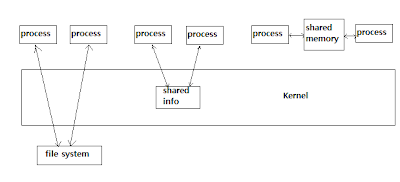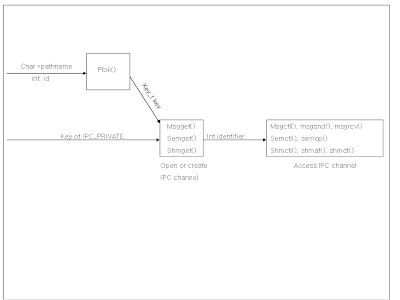IPC Introduction
Introduction
IPC란 프로세스간의 통신을 의미하며 전통적으로는 서로 다른 프로세스간의 여러 가지 메시지 전송 방법을 의미하였지만 최근에는 공유메모리 같은 새로운 방법이 도입되어 동기화 등 여러 가지 방법을 소개한다.
최근 30년간 유닉스 운영체제의 진화과정에서 메시지 전송방식은 아래와 같이 변화되어왔다.
1. Pipes
IPC에서 가장 널리 쓰이며 특히 프로그램이나 셀에서 가장 많이 쓰는 방식이며 각 프로세스는 동일한 조상 프로세스(부모-자식 프로세스 관계)를 가지고 있어야 하는 단점이 있다.
2. System V message queues
80년도 초 System V 커널에 도입되었으며 특정 호스트 내에서는 프로세스간의 관계가 없어도 메시지 전송이 가능하다.
3. Posix message queues
Posix realtime standard에 의해서 추가되었다.
4. Remote Procedure Calls
80년대 중반에 소개되었으며 이 기종간의 함수호출에 사용되어진다.
Processes, Threads, and the Sharing of Information
유닉스 프로세스간의 정보 공유는 아래와 같이 여러 가지 방법으로 공유되어질 수 있다.
 |
| Different Data Sharing |
오랫동안 유닉스 시스템은 프로세스 방식을 사용해왔으며 쓰레드 개념이 나온지는 최근이다. Posix.1의 쓰레드 표준이 승인된 것이 1995년이다. 주어진 프로세스내의 쓰레드는 전역변수를 공유하므로 변수 공유 시 동기화 문제가 발생한다. 공유데이터 동기화 하는 여러 가지 방법이 제공된다.
Persistence of IPC Objects
IPC 객체의 생성 소멸기간은 다음과 같이 세가지로 분류되어진다.
1. Process-persistent IPC
Open된 IPC 객체를 소유한 마지막 프로세스가 IPC 객체를 close 할 때까지 존재한다.
2. Kernel-persistent IPC
커널이 재부팅 되거나 강제로 IPC 객체를 지울 때까지 존재한다.
3. Filesystem-persistent IPC
강제로 IPC 객체를 지울 때 까지 존재한다.
System V IPC
Introduction
세가지의 IPC는 아래와 같다.
· System V message queues
· System V semaphores
· System V shared memory
각각의 함수는 다음과 같다.
| Message queues | Semaphores | Shared memory |
Header | sys/msg.h
| sys/sem.h | sys/shm.h
|
Function to create or open | msgget | semget | shmget |
Function for control operations | msgctl | semctl | shmctl |
Functions for IPC operations | msgsnd msgrcv | semop | shmat shmdt |
Summary of System V IPC functions.
key_t Keys and ftok Function
sys/types.h 에서 key_t type을 정의하는데 보통 32bit 정수형으로 정의된다. ftok 함수는 pathname과 정수형 id를 입력받아 key_t type 값을 리턴한다.
#include
key_t ftok(const char *pathname, int id);
returns: IPC key if OK, -1 or error
이 함수는 pathname과 id의 low-order 8bit의 조합으로 정수형 IPC 키를 생성한다.
ipc_perm Structure
커널은 파일을 관리하는 것처럼 IPC 객체에 대한 정보도 관리하는데 아래와 같은 구조체로 되어있다.
struct ipc_perm
{
uid_t uid; // owner’s user id
gid_t gid; // owner’s group id
uid_t cuid; // creator’s user id
gid_t cgid; // creator’s group id
mode_t mode; // read-write permissions
ulong_t seq; // slot usage sequence number
key_t key; // IPC key
};
Creating and Opening IPC Channels
세 개의 get_XXX 함수는 IPC 객체를 생성하거나 열수 있는데 모두다 IPC key 값을 이용하여 정수형 identifier를 얻는다. 함수의 인자로 키 값을 넣을 때 두 가지 방법이 있다.
1. Pathname과 id를 이용하여 ftok 함수를 호출한다.
2. Key를 IPC_PRIVATE로 명시한다. Key가 IPC_PRIVATE이면 IPC 객체가 새롭고 유일하게 생성된다.
 |
| Generating IPC identifiers from IPC keys |
모든 get_XXX 함수들은 read-write permission을 갖는다.
1. Key가 IPC_PRIVATE이면 유일한 IPC 객체가 생성되는 것을 보장한다.
2. oflag 비트를 IPC_CREATE로 설정했을 때 엔트리가 존재하지 않으면 특정 키에 대한 새로운 엔트리를 생성하고 기존에 있다면 기존의 엔트리를 리턴한다.
3. oflag 비트를 IPC_CREATE 와 IPC_EXCL로 설정했을 때는 기존에 엔트리가 존재하지 않을 때만 새로운 엔트리를 생성하고 존재한다면 오류상수 EEXIST를 리턴한다.
요약하면 아래 그림과 같다.
 |
| Logic for creating or opening an IPC object |
Shared Memory
Shared Memory Introduction
공유 메모리는 IPC중에서 가장 빠르다. 메모리가 프로세스 의 어드레스 스페이스에 한번 매핑만 되면 프로세스간의 데이터 전송 시 커널의 개입이 필요치 않다.
아래의 그림을 보면 이유가 설명이 될 것이다.
 |
| Flow of file data from server to client |
 |
| Copying file data from server to client using shared memory |
System V Shared Memory
Introduction
모든 공유메모리 세그먼트는 sys/shm.h 에서 정의된 shmid_ds 구조체를 가지고있다.
struct shmid_ds
{
struct ipc_perm shm_perm; // operation permission struct
size_t shm_segsz; // segment size
pid_t shm_lpid; // pid of last operation
pid_t shm_cpid; // creator pid
shmatt_t shm_nattch; // current # attached
shmat_t shm_cnattch; // in-core # attached
time_t shm_atime; // last attach time
time_t shm_dtime; // last detach time
time_t shm_ctime; // last change time of this structure
}
shmget Function
공유메모리를 생성하거나 기존의 공유메모리를 접근한다.
#include
int shmget(key_t key, size_t size, int oflag);
returns: shared memory identifier if OK, -1 on error
리턴값을 공유메모리 identifier 라고 하며 공유메모리를 접근하기위한 나머지 세개의 shm_XXX 의해 사용되어진다.
Size는 바이트 단위의 공유메모리 세그먼트의 크기를 나타낸다. Oflag는 read-write 권한을 의미한다.
shmat Function
공유메모리 세그먼트가 생성되거나 개방된후 shmat 함수 호출로 메모리 접근을 할수있다.
#include
void *shmat(int shmid, const void *shmaddr, int flag);
returns: starting address of mapped region if OK, -1 on error
shmid는 shmget함수에서 린턴된 값이다. Shmat의 리턴값은 공유메모리의 시작번지이다
shmdt Function
프로세스가 끝났을 때 공유메모리를 detatch 한다.
#include
int shmdt(const void *shmaddr);
returns: 0 if OK, -1 on error
shmdt 함수 호출로 공유메모리 세그먼트가 지워지는 것은 아니다.
shmctl Function
공유메모리에 관계된 여러가지 기능을 제공한다.
#include
int shmctl(int shmid, int cmd, struct shmid_ds *buff);
returns: 0 if OK, -1 on error
세게의 command가 제공된다.
IPC_RMID | Remove the shared memory segment identified by shmid from the system and destroy the shared memory segment |
IPC_SET | Set the following three members of the shmid_ds structure for the shared memory segment from the corresponding members in the structure pointed to by the buff argument: shm_perm.uid, shm_perm.gid, and shm_perm.mode. The shm_ctime value is also replaced with the current time. |
IPC_STAT | Return to the caller(through the buff argument) the current shmid_ds structure for the specified shared memory segment |
* referenced by
Unix Network Programming (Interprocess Communications) by W. Richard Stevens





